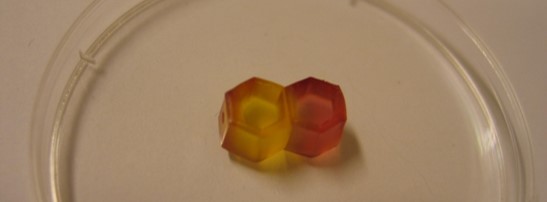Stereolithography is an additive manufacturing process which employs a VAT of liquid curable photopolymer and a video projector to build parts’ layers one at a time. For each layer, the beam traces a cross-section of the part pattern on the surface of the liquid resin. Exposure to the light solidifies the pattern traced on the resin and joins it to the layer below.

B9 Creator printer
Significant parameters :
- Resolution max : 30 µm on the XY axis and 5 µm on the Z axis.
- Maximum volume : 104x76x200 mm

Diagnostic test prototype
Material 1 = Polyacrylate resin
- Need a photo-initiator,
- Very strong,
- Can be transparent and clear,
- Thermal stability up to 250°C,
- More accurate,
- Ideal for parts requiring dimension down to 50 µm.

Submilimeter micro-structure
Material 2 = polyethylene glycol
These 4D printed objects, by the access to unprecedented sensing layer complex geometries, generate biological diagnostic devices such as immunosensors but also enzymatically active 3D objects for biosensing and catalysis.
![]()


